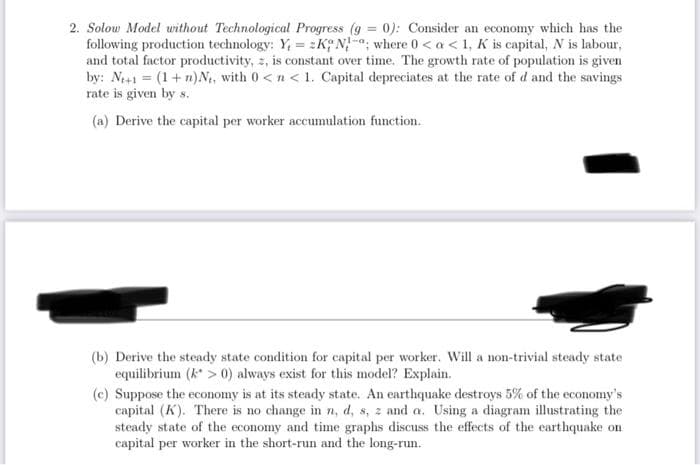2. Solow Model without Technological Progress (g = 0): Consider an economy which has the following production technology: Y, = zKNa, where 0 < a< 1, K is capital, N is labour, and total factor productivity, z, is constant over time. The growth rate of population is given by: N+1 = (1+n)N, with 0 0) always exist for this model? Explain. (c) Suppose the economy is at its steady state. An earthquake destroys 5% of the economy's capital (K). There is no change in n, d, s, z and a. Using a diagram illustrating the steady state of the economy and time graphs discuss the effects of the earthquake on capital per worker in the short-run and the long-run.
2. Solow Model without Technological Progress (g = 0): Consider an economy which has the following production technology: Y, = zKNa, where 0 < a< 1, K is capital, N is labour, and total factor productivity, z, is constant over time. The growth rate of population is given by: N+1 = (1+n)N, with 0 0) always exist for this model? Explain. (c) Suppose the economy is at its steady state. An earthquake destroys 5% of the economy's capital (K). There is no change in n, d, s, z and a. Using a diagram illustrating the steady state of the economy and time graphs discuss the effects of the earthquake on capital per worker in the short-run and the long-run.
Chapter1: Making Economics Decisions
Section: Chapter Questions
Problem 1QTC
Related questions
Question
6

Transcribed Image Text:2. Solow Model without Technological Progress (g = 0): Consider an economy which has the
following production technology: Y, = zK N-a, where 0 < a < 1, K is capital, N is labour,
and total factor productivity, z, is constant over time. The growth rate of population is given
by: N+1 = (1+ n)N, with 0<n< 1. Capital depreciates at the rate of d and the savings
rate is given by s.
%3D
(a) Derive the capital per worker accumulation function.
(b) Derive the steady state condition for capital per worker. Will a non-trivial steady state
equilibrium (k > 0) always exist for this model? Explain.
(c) Suppose the economy is at its steady state. An earthquake destroys 5% of the economy's
capital (K). There is no change in n, d, s, z and a. Using a diagram illustrating the
steady state of the economy and time graphs discuss the effects of the earthquake on
capital per worker in the short-run and the long-run.
Expert Solution
This question has been solved!
Explore an expertly crafted, step-by-step solution for a thorough understanding of key concepts.
This is a popular solution!
Trending now
This is a popular solution!
Step by step
Solved in 5 steps with 5 images

Knowledge Booster
Learn more about
Need a deep-dive on the concept behind this application? Look no further. Learn more about this topic, economics and related others by exploring similar questions and additional content below.Recommended textbooks for you


Principles of Economics (12th Edition)
Economics
ISBN:
9780134078779
Author:
Karl E. Case, Ray C. Fair, Sharon E. Oster
Publisher:
PEARSON

Engineering Economy (17th Edition)
Economics
ISBN:
9780134870069
Author:
William G. Sullivan, Elin M. Wicks, C. Patrick Koelling
Publisher:
PEARSON


Principles of Economics (12th Edition)
Economics
ISBN:
9780134078779
Author:
Karl E. Case, Ray C. Fair, Sharon E. Oster
Publisher:
PEARSON

Engineering Economy (17th Edition)
Economics
ISBN:
9780134870069
Author:
William G. Sullivan, Elin M. Wicks, C. Patrick Koelling
Publisher:
PEARSON

Principles of Economics (MindTap Course List)
Economics
ISBN:
9781305585126
Author:
N. Gregory Mankiw
Publisher:
Cengage Learning

Managerial Economics: A Problem Solving Approach
Economics
ISBN:
9781337106665
Author:
Luke M. Froeb, Brian T. McCann, Michael R. Ward, Mike Shor
Publisher:
Cengage Learning

Managerial Economics & Business Strategy (Mcgraw-…
Economics
ISBN:
9781259290619
Author:
Michael Baye, Jeff Prince
Publisher:
McGraw-Hill Education